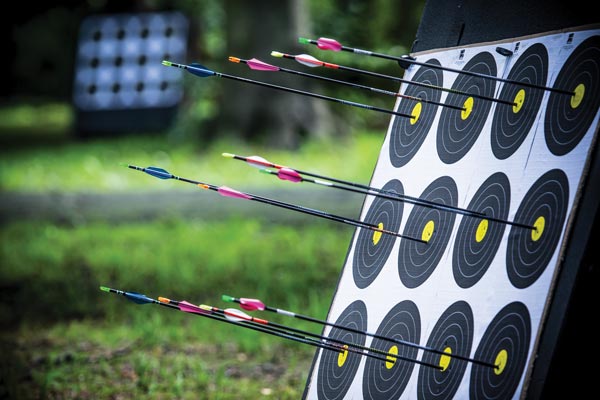Adrian Tippins discusses what type of spin wings to go for when making the switch from plastic vanes…

The thing to remember is that as the stabilisation increases so does the level of drag which can cut down on arrow speed and distance as well as making the arrow more susceptible to cross wind drift
Q. I’m thinking about making the switch from plastic vanes to spin wings but don’t know which ones to choose. Can you help?
A. There are three main elements to consider when choosing spin vanes/wings. These are length, profile (height & shape) and stiffness. Spin vanes stabilise, steer and spin the arrow. To do all of these successfully, all three of the above elements have to be correct. There’s no real formula for success as all archers are individuals but following some basic guidelines will get you off to a great start. The length of vane needed is directly proportionate to the length and weight of the arrow. A 30” arrow will obviously need more stabilisation assistance than a 25” arrow. Stabilisation can be gained from having a taller vane, but this can lead to some clearance problems for recurve archers.
A better way is to opt for low-profile vanes on recurve arrows and up the length as necessary. In most cases a 50mm or 1.85” vanes will be sufficient for most outdoor arrows from 27” to 30” inches. Arrows over 30” may well benefit from 60mm vanes and arrows under 27” may shoot better with 40mm vanes. The thing to remember is that as the stabilisation increases so does the level of drag which can cut down on arrow speed and distance as well as making the arrow more susceptible to cross wind drift. As these factors don’t affect indoor shooting it’s not uncommon to see 100mm vanes in use. The shape and profile of the vanes has a big part to play in the stability stakes. Vanes that have a small shield cut rear will offer a higher degree of stability as the cut efficiently disperses divergent air currents. Vanes that have a smooth parabolic shape will have slippery aerodynamics and maximise arrow speed. Vanes such as XS-Wings employ the design of a steep leading edge. This “Delta” wing design can offer quicker stabilisation and steering over shorter distances settling the arrow quicker than other designs. These have been really popular with customers over the past few years.
Recently, more & more emphasis has been placed on ‘spining’ the wings to the bow correctly. On exiting the bow a wing grabs the air and fills up like a ships sail which starts the arrow rotating. If the air pressure is too high from the power of the bow and the wing is too floppy it will distort and lose its efficiency. This why a lot of companies have now moved to stiffer materials and now mark the stiffness grades on their merchandise to offer the end user a choice.
Compound shooters will certainly need pretty stiff wings. The curvature of vanes also differ greatly. For example XS-Wings & Spider vanes are straighter than Gas Pro vanes which very low profile but are also very helical and look like little fan blades when viewed from the rear. Range-o-Matic Mylar vanes have a very flipped over top edge for the air to ‘get under’. Different manufacturers have different approaches on aerodynamics. A good example of this is the new KSL Jet 6 vanes. These are ribbed to channel air out the back of the arrow and minimise the vortex stream giving quicker stabilisation and diminishing the effects of archers paradox.
There’s a lot of intense marketing surrounding wings and vanes and it’s easy to bow to peer pressure to ‘keep up with the Joneses’ and experienced archers with the clubs. As wings are easily attached and removed, why not try asking fellow archers if you can borrow a few to try on an arrow? Hopefully you can get a few different kinds to pitch head to head in an attempt to detect the differences and make an informed decision from the test. Finally, once you have made your decision don’t forget to purchase wings in your correct hand orientation, left or right.
This article originally appeared in the issue 124 of Bow International magazine. For more great content like this, subscribe today at our secure online store www.myfavouritemagazines.co.uk


There are three type of spin wings vanes we have. Normal, elite,original.I think most of the recurve Olympic archers are using the original spin wing vanes. Because it is the lighter than elite one.